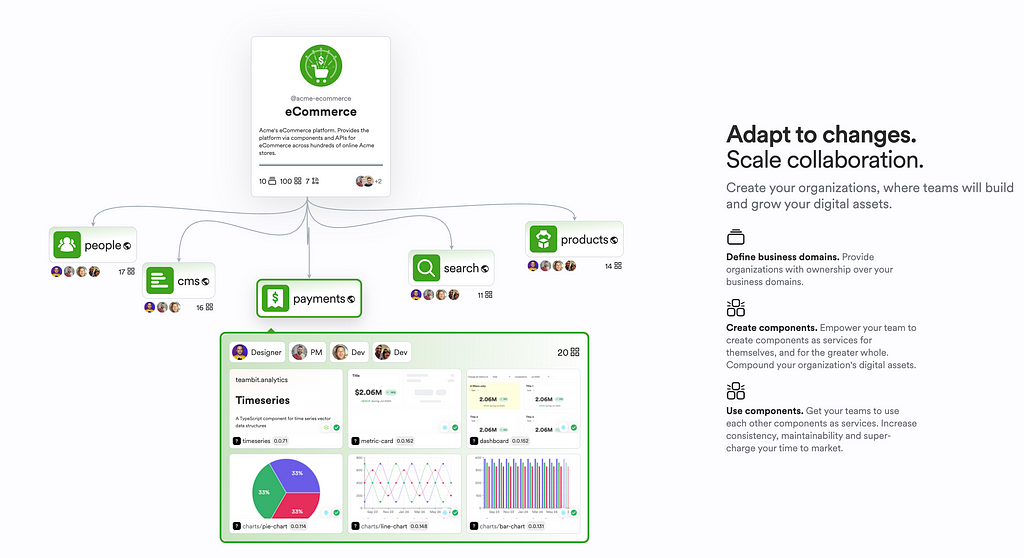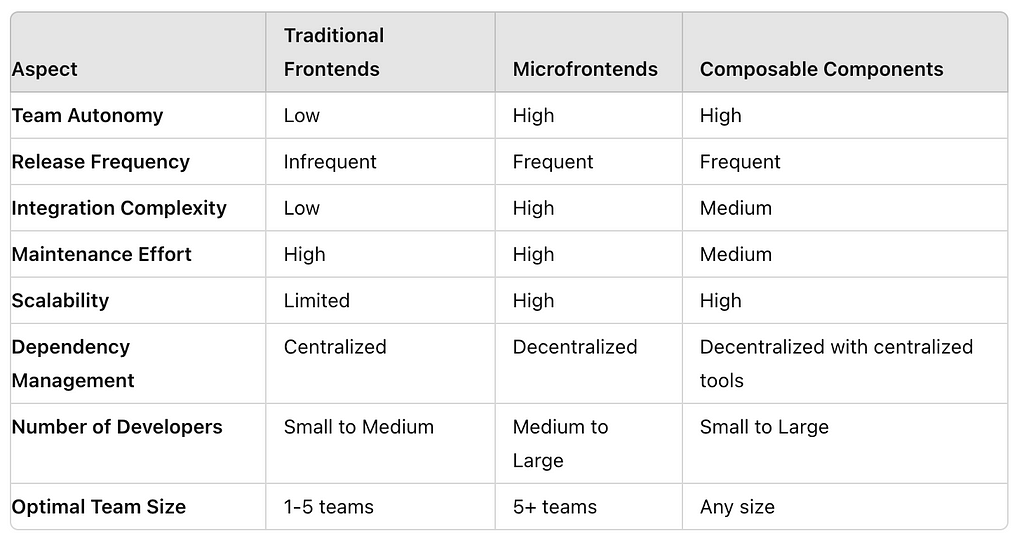This content originally appeared on Bits and Pieces - Medium and was authored by Ashan Fernando
Not every application needs to follow microfrontend architecture, at least not initially.

Microfrontends can offer significant advantages for web applications, but most of these benefits take time to materialize. In most cases initial costs and complexity can outweigh the benefits, especially for startups that iterate though different set of features to find the product market fit.
Therefore this architecture style may fit applications that are large in size and experiencing bottlenecks on releases and quality due to the scale. Even for applications that has a huge scope, starting to develop with multiple teams could benefits from it.
Microfrontends are a powerful tool for scaling applications and teams, but their complexity and costs mean they are best suited for large, dynamic projects where long-term benefits justify the initial investment.
Understanding the Complexity of Microfrontends
One of the fundemental challenges microfrontends face is that it introduce a layer of complexity that can shift focus from feature development to dealing with architectural concerns. Unless you can realize its returns in a short period of time, its not worth the effort and could end up with diminishing returns. Here are some key challenges to consider:
Architectural Overhead of microfrontends
Implementing microfrontends requires significant upfront architectural planning, often referred to as an “architectural runway.” This runway includes existing code, components, and technical infrastructure necessary for implementing near-term features with minimal redesign and delay. While crucial, it can divert resources from feature development.
Tip: Start with a clear architectural plan but stay flexible. The goal is to minimize disruption during the transition to microfrontends.
Balancing Emergent Design with Intentional Architecture
Agile development promotes emergent design — defining and extending architecture as necessary to deliver functionality. However, this approach alone can’t handle the complexity of large-scale solutions. Relying solely on emergent design can lead to increased delivery costs, one-off solutions, security issues, and poor interoperability. Balancing emergent design with intentional architecture requires centralized planning and cross-team coordination.
The best architectures, requirements, and designs emerge from self-organizing teams.— Agile Manifesto
One technique to make the the frontend architecture flexible is to use a composable architecture style, that makes the entire frontend build with loosely coupled components. This empowers emergent design and make the architecture flexible enough to break it into parts based on ownership and autonomy with minimal friction.

Complex DevOps and Release Management
With microfrontends, DevOps becomes more complex. Each microfrontend may have its own build, test, and deployment pipeline, leading to increased maintenance and coordination efforts.
Releases also become more challenging, as ensuring compatibility and integration between different microfrontends adds another layer of complexity. For instance, integrating a new feature might require synchronizing multiple microfrontend teams, each with its own deployment schedule and testing protocols.
And, understanding this complexity will help you to see whether its worth in invest for autonomy of your microfrontend teams vs the effort you put for managing DevOps.
Integration Testing Challenges
In a microfrontend architecture, integration testing shifts right instead of left. Thorough integration testing can only occur after individual microfrontends are developed and integrated, potentially delaying the detection of integration issues and increasing the risk of late-stage defects.
For example, a bug discovered during the integration phase may require multiple teams to coordinate fixes, extending the release timeline.
Tip: Implement continuous integration and continuous delivery (CI/CD) pipelines to ensure smooth and timely integration of microfrontends.
You can reduce the impact by adopting a frontend development style where each component can be developed, tested independent from the application. In simple terms, check whether you can develop your component without running the application development server.
For example tools like Bit, Storybook helps this cause by providing separate development server to preview components.
When Microfrontends Make Sense
Despite the challenges, microfrontends are beneficial when an application and its development team reach a certain scale. Here’s when microfrontends become valuable:
Autonomy and Faster Releases at Scale
Microfrontends enable autonomy and faster releases at scale. When a frontend grows beyond a certain point, managing a single codebase becomes cumbersome. Breaking down the frontend into microfrontends allows teams to work independently, reducing dependencies and improving release velocity.
For example, an e-commerce platform with separate teams for product listings, user accounts, and checkout can develop and deploy features independently without waiting for other teams.
Microfrontends empower teams to develop, test, and release features independently, enhancing agility and speed.
Managing Large Development Teams
As the development team grows, collaboration within a single codebase can become inefficient. Different teams working on the same codebase can lead to conflicts and delays. Microfrontends allow teams to own specific parts of the application, reducing cross-team dependencies and improving productivity.
Avoiding Premature Microfrontends
It’s crucial to recognize that breaking an application into microfrontends too early can be counterproductive. Initially, teams will have to work together across different microfrontends, complicating coordination and development. Instead, it’s more practical to adopt microfrontends at a later stage when the application and team have grown sufficiently to justify the transition.
Tip: Evaluate the scale and complexity of your application before deciding to transition to microfrontends. Premature adoption can lead to unnecessary overhead.
Making the Transition Easier
To ease the transition from a monolithic frontend to microfrontends, making your code composable is key. Composable architectures allow for more manageable and flexible development, facilitating the eventual shift to microfrontends. Here’s one of the proven techniques to achieve this:
Composable Architectures with Bit
As discussed earlier, Bit is a platform that helps build composable software architectures. By breaking down your application into independent, reusable components, you can manage dependencies, enable independent development, and visualize dependencies more effectively. This approach ensures that your application can evolve smoothly without significant refactoring.
Composable architectures provide the flexibility and scalability needed to transition seamlessly to microfrontends.
Key Benefits of Composable Architectures
- Enhanced Flexibility: Adopting different styles and patterns becomes easier.
- Scalability: Individual components can be scaled as needed, optimizing resource utilization.
- Maintainability: The modular nature simplifies maintenance and updates.
- Innovation and Speed: Reusable components accelerate development cycles and foster innovation.
- Better Dependency Management: Tools like Bit manage component dependencies, ensuring stability across projects.
Tools and Ecosystem
Although you may have thousands of components, modern tools allow developers to work with only the components they need locally. This makes contributing to the codebase more manageable, maintaining the impression of working with a single codebase while each component has its own repository.
Tip: Invest in tools that support component-based development to streamline the transition to microfrontends.

Conclusion
Microfrontends offer significant advantages for large-scale applications with substantial development teams. However, they come with complexity and are not necessary for every application, especially in the early stages.
By making your code composable and adopting a flexible architecture, you can prepare for a smoother transition to microfrontends when the time is right. This approach ensures that your application can grow and evolve with minimal friction, allowing you to reap the benefits of microfrontends at the appropriate stage.
Learn More
- Mastering Micro Frontends: 9 Patterns Every Developer Should Know
- Scaling Microfrontends: Every Developer Should Know
- Increasing Agility in Microfrontend Design: A Developer’s Guide
- JavaScript Monorepos: Exploring Decentralized Alternatives
Micro Frontend Architecture: Not for Everyone? was originally published in Bits and Pieces on Medium, where people are continuing the conversation by highlighting and responding to this story.
This content originally appeared on Bits and Pieces - Medium and was authored by Ashan Fernando
Ashan Fernando | Sciencx (2024-07-31T07:22:32+00:00) Micro Frontend Architecture: Not for Everyone?. Retrieved from https://www.scien.cx/2024/07/31/micro-frontend-architecture-not-for-everyone/
Please log in to upload a file.
There are no updates yet.
Click the Upload button above to add an update.
